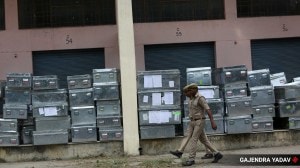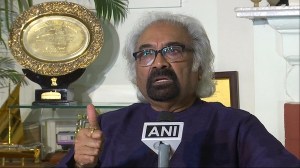- India
- International
Explained: How Agra, Bhilwara and Pathanamthitta coronavirus models differ
Coronavirus (COVID-19): After early cases in Agra, Bhilwara and Pathanamthitta, respective state and district administrations worked hard to contain the outbreak within those geographies. Model by model, how they went about it.
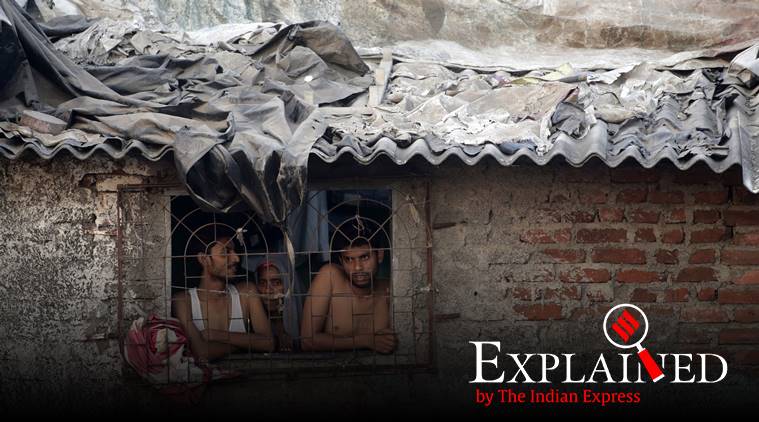 India’s coronavirus lockdown is to end on April 14. In the last 21 days, states have scaled up efforts to tackle the COVID-19 outbreak. Most health policy experts say, “There is no one size fits all”. (File Photo)
India’s coronavirus lockdown is to end on April 14. In the last 21 days, states have scaled up efforts to tackle the COVID-19 outbreak. Most health policy experts say, “There is no one size fits all”. (File Photo)
Coronavirus (COVID-19): In the lead-up to the meeting between the Prime Minister and state Chief Ministers, from which it emerged on Saturday that the national lockdown would continue for now, different states had come up with their own different models for containing the COVID-19 spread within smaller geographies. As most health policy experts would say, “There is no one size fits all”.
At least three of the regional models for cluster containment — Agra (Uttar Pradesh), Bhilwara (Rajasthan) and Pathanamthitta (Kerala) — have been mentioned in several high-level meetings with the states during the past week. One was showcased by the Centre at the consolidated COVID-19 press briefing last week. Read live updates on the coronavirus pandemic
Coronavirus (COVID-19): The Agra model
The “Agra model” emerged in early March. Two men who had travelled to Austria with a relative — later Delhi’s first COVID-19 case — went home to Agra where, days later, six positive cases were found. What followed was a localised yet massive combing operation for contacts, carried out by the district administration and Integrated Disease Surveillance Programme personnel. A congested area, within a 3-km radius in Lohamandi of Agra, was cordoned off immediately after the positive reports arrived at 2 am, and 1,248 teams carried out intensive contact tracing over 1,65,000 households.
The Health Ministry said in a statement: “The State, District administration and frontline workers coordinated their efforts by utilizing their existing Smart City Integrated with Command and Control Centre (ICCC) as War Rooms. Under the cluster containment and outbreak containment plans, the district administration identified epicentres, delineated impact of positive confirmed cases on the map and deployed a special task force as per the micro plan made by the district administration. The hotspots were managed through an active survey and containment plan. Area was identified within radius of 3 Km from the epicenter while 5 Km buffer zone was identified as the containment zone.”
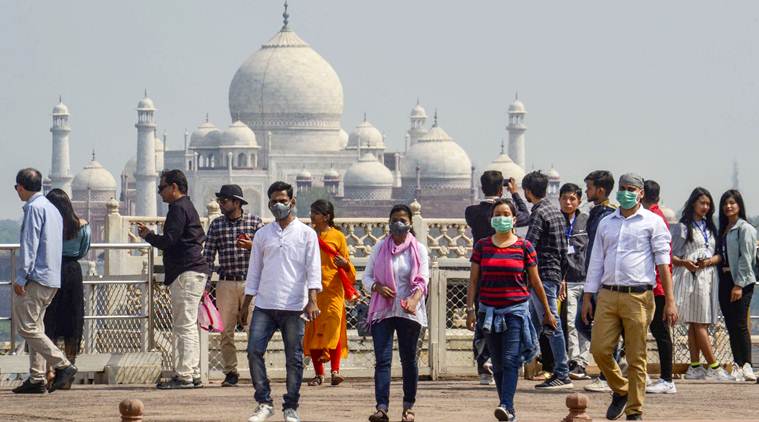 Coronavirus: Tourist wear protective masks in wake of the deadly novel coronavirus, at Taj Mahal, in Agra, March 5. (PTI Photo)
Coronavirus: Tourist wear protective masks in wake of the deadly novel coronavirus, at Taj Mahal, in Agra, March 5. (PTI Photo)
In the containment zone, Urban Primary Health Centres were roped in. Each of the 1,248 teams had 2 workers including ANMs/ASHA/AWW reaching out to 9.3 lakh of people through household screening. Additionally, effective and early tracking of first contact tracing was thoroughly mapped.

The Agra model is important because it has proved effective in areas of high case density, which are being referred to as “hotspots”. Agra was also the earliest reference to community transmission in an official statement. Community transmission is said to have happened when cases start being detected where there are no clear indications of travel history to an affected country, or of contact with a confirmed positive case. Experts such as AIIMS director Dr Randeep Guleria are now talking about “localised community transmission” in hotspots.
Also read | Slight but ‘noticeable’ flattening of growth curve in India
In a statement on March 5, the Health Ministry said: “Since, in addition to COVID 19 cases related to travel, some cases of community transmission have also been observed, it has been decided to involve district collectors and States have been asked to form rapid response teams as the district, block and village levels.”
Coronavirus (COVID-19): Bhilwara model
Rajasthan’s Bhilwara was one of the early hotspots for COVID-19. It has now spotlighted itself with a “ruthless containment strategy”, also being described as the “Bhilwara model”.
According to a March 26 report by the district collector’s office, the first positive case in Bhilwara, reported on March 19, was a doctor at a private hospital. By March 26, the number of positive cases at the hospital was 17, all of them hospital staff and patients. The outbreak emerged as a massive crisis for the Rajasthan government as the doctors, before testing positive, had communicated with several people, including nursing staff and patients.
 India coronavirus (COVID-19) lockdown: JMC workers fumigate the area around Hawa Mahal as a precautionary measure to contain the spread of coronavirus, during the nationwide lockdown, in Jaipur. (PTI Photo)
India coronavirus (COVID-19) lockdown: JMC workers fumigate the area around Hawa Mahal as a precautionary measure to contain the spread of coronavirus, during the nationwide lockdown, in Jaipur. (PTI Photo)
The city was completely isolated with Section 144 CRPC being imposed. In the first phase, essential services were allowed; in the second phase, there was a total shutdown with the city and district borders sealed and checkposts set up at every entry and exit point. All trains, buses and cars were stopped. The District Magistrates of neighbouring districts too were asked to seal their borders. The containment zone is usually 3 km around the epicentre, and the buffer zone is 7 km.
The containment and buffer zones were turned into ‘No-Movement’ zones and cluster mapping was done for COVID-19 cases. Through this, six areas were identified and special teams were deployed for continuous screening of suspected cases. The containment and buffer zones, all ambulances and police vehicles, the screening centre and quarantine centres, the Collectorate, Police Line and other public-dealing offices were disinfected on a daily basis.
📢 Express Explained is now on Telegram. Click here to join our channel (@ieexplained) and stay updated with the latest
At last count, 3,072 teams in Bhilwara had surveyed 2,14,647 households comprising 10,71,315 people and found 4,258 cases of influenza-like illnesses that had to be tested for COVID-19. Four private hospitals were acquired with 25 isolation beds each. Quarantine centres were set up in 27 hotels with 1,541 rooms, which eventually housed 950 people, while 7,620 people were kept in home quarantine.
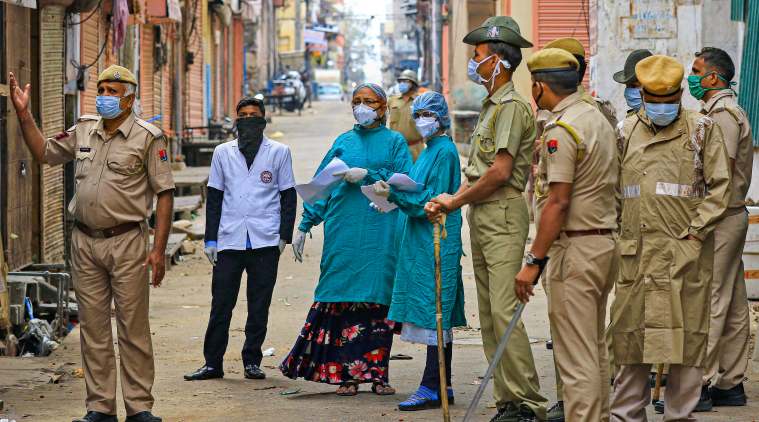 Medical team members during their door-to-door visit to screen people in wake of coronavirus pandemic, during the nationwide lockdown, at Ramganj Bazar in Jaipur, Friday, March 27, 2020. (PTI Photo)
Medical team members during their door-to-door visit to screen people in wake of coronavirus pandemic, during the nationwide lockdown, at Ramganj Bazar in Jaipur, Friday, March 27, 2020. (PTI Photo)
There was door-to-door supply of essential groceries, fruits, vegetables and milk. Raw and cooked food packets were distributed to the needy and there was a complete shutdown of industries, factories & brick-kilns.
Bhilwara currently has about 28 cases, according to Health Ministry data.
Coronavirus (COVID-19): Pathanamthitta model
Technology has been the hallmark of the Pathanamthitta model in Kerala. The district saw its first cases in early March, when a three-member Italy-returned family ended up infecting several relatives while socialising with them. The count would eventually go up to 16.

Border sealing and contact tracing happened here too. But more than just screening contacts, every person who had entered the district was screened and a database created so that they could be easily reached at short notice. In addition, graphics were created showing the travel route of the positive cases and publicised. This included details of all places the family had travelled to, and the potential contacts they would have made there between February 29 and March 6.
This helped in self-reporting. As people realised from the route maps that they had indeed come in contact with a COVID-19 positive person, many walked up to be screened or treated.
Those under quarantine were checked daily on phone thorough a call centre even as 14 teams of health workers monitored some 4,000 people who had entered the district before its sealing.
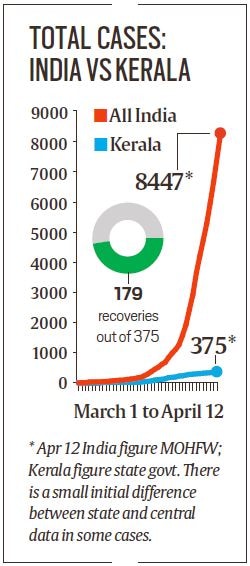 There was also an app — Corona RM — designed by engineering students of IHRD College, Chengannur. Those under home quarantine were monitored through this app as their whereabouts could be tracked and if they broke quarantine that could be immediately detected through the use of GP.
There was also an app — Corona RM — designed by engineering students of IHRD College, Chengannur. Those under home quarantine were monitored through this app as their whereabouts could be tracked and if they broke quarantine that could be immediately detected through the use of GP.
The growth of new cases has slowed down in Kerala, with six of the last 10 days witnessing a single-digit rise.
Here’s a quick Coronavirus guide from Express Explained to keep you updated: What can cause a COVID-19 patient to relapse after recovery? | COVID-19 lockdown has cleaned up the air, but this may not be good news. Here’s why | Can alternative medicine work against the coronavirus? | A five-minute test for COVID-19 has been readied, India may get it too | How India is building up defence during lockdown | Why only a fraction of those with coronavirus suffer acutely | How do healthcare workers protect themselves from getting infected? | What does it take to set up isolation wards?
More Explained
EXPRESS OPINION
Apr 24: Latest News
- 01
- 02
- 03
- 04
- 05




















